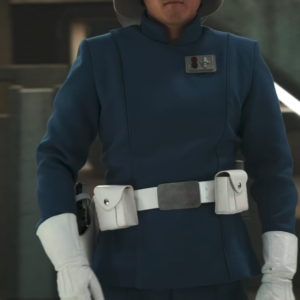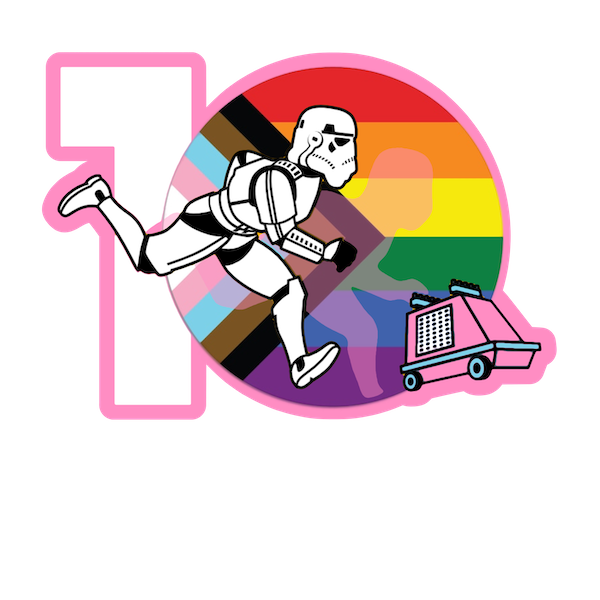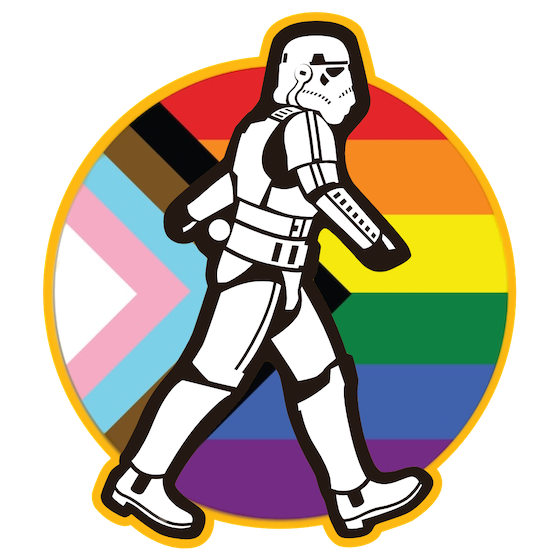It is easy to get distracted by the noise and get stuck because of others opinions. Things have vastly evolved since I first started in 2009, however the first piece of advise I got still applies today: Your costume Your choice !!
ultimately, it is YOUR costume; ONLY YOU can decide how deep into details you want to go…

Accuracy is probably the most important world in the costuming community…
but what does it mean?
Each costuming community has its own way to establish their standards, the 501st uses the Costumer Reference Library (CRL) which outlines for each character what elements should be present. With more releases, more access to social media, set pictures, behind the scene shots, etc… the amount of information available today far supersedes whatever was available 10, 20, 30 years ago. As a matter of fact the length of said CRL have drastically increased since I first started my journey into costuming back in 2009. With the current digital media, 4K TVs, one can easily go frame-by-frame to access this information and can easily become a Star Wars Accuracy Tigers (S/W/A/T); hunting for the smallest prey. The goal still remains “Accuracy”; that is the design patterns, materials, positioning etc. of a particular piece of garment and/or full ensemble. Some of these items maybe found parts – existing in the real world- that have been modified (or not) OR made by the wardrobe department for a particular use. Clothing, footwear and accessories will likely be composed of a mix of made-to-purpose and found items. So begins the tedious journey searching for the “most accurate” costume… which can mean different things to different people. Throughout my many discussions with many (many many) costumers around the world I have identified the following interpretations of accuracy.
Screen Accuracy –
truth by moving images for the Costumors
In order to be “screen accurate” a costume would have to look, down to the smallest details, to what can be observed on screenshots. In this case the closest you come to what can be identified on screen, the closest to accuracy you can reach. The key here is “what can be seen” matters; while for some characters, this is a pretty straight forward tasks considering the amount of screen time and variety of shots; it is not always the case. Not all costumes can be seen in their full details on screen; the visual information may not be sufficient and would need to be supplemented with pictures from the set or verifiable information directly from the source (designer, production…) – which one could argue means going towards set accuracy.
Set Accuracy –
truth from the filming for the Collectors
A set accurate costume is one that reflects what can be seen on the filming set. While the general design pattern does not change, some smaller details maybe easier to spot. However such details may then give conflicting information since several iteration of a costumes may be used in the same shoot (or reshoot) or appear on rush…. the same character’s vest may have pockets or not depending on the shot. Because not everything that is filmed makes it on screen, some details maybe more pertinent to Set Accuracy than Screen Accuracy. There are three main sources of information being used in this case:
Actual written interviews with production crew and cast where some details are discussed; Pictures, video taken on set ; usually behind the scene or for production purposes, or shared on socials by cast and crew; Archive pictures from the actual used costumes; these can be found in various books, through the sales of original props, official costumes displayed for exhibitions and in conventions.
Visual Accuracy –
truth from the general public
This refers to how the costume is perceived by the majority of people ( general public) when seen. While maybe not as detailed as the two above, a visually accurate costume remains at the highest level of quality and making. The weathering may not be perfect or existent, the greeblies are painted resin instead of metal or vice versa, the armour is 3D printed and not vacformed, the ABS used is 0.8 instead of 0.9, the fabric of your jumpsuit is a mix blend 80/20 instead of 100% cotton…. Whatever the case is, it does not change the fact that visually you are this character, and for 99% of people (except for the S/W/A/T) you absolutely look the part. The final costume clearly does not look like a halloween production; the colour, material, accessories, down to the demeanour – everything looks and feel right. In other words, for the general public, they are seeing actual characters straight out of the movie.
The making of the costume is based on the same reference materials as the previous two kinds; which sometimes is complemented with secondary and tertiary sources such as referencing other similar costumes found in the same universe, existing commercial design patterns, collectibles… When too many details information have to rely on secondary and tertiary sources, one could argue that screen accuracy is not possible and thus while “accurate”, a costume is not “screen accurate” and falls under “visual accuracy”.
Origin Accuracy –
truth from the conceptual work
During any production there will be series of discussions and proposals; conceptual design will start to make their way and some may be “made available” to the public. These conceptual drawing may offer some information on the “intentions”. Whether these found their way as is or were changed during production for a variety of reasons is irrelevant. Sufficiently detailed drawings, 3D art can enable a “concept” costume. Of course in these cases, there may be a lot of estimations made by the costumer in terms of what material must be used.
There is also something to be said towards production “mistakes”. While a full costume maybe intended to be worn in a specific way, some mistakes may happen and find their way on the final screen published material. Arguments are made both ways as it was intended (or not intended) thus should or should not be considered “accurate”; it seems the idea that “ if it shows on screen, it therefore is” can and is effectively being questioned by some of the most astute character experts.
Residual Memory Accuracy –
truth from our memories
This is probably a more anecdotal one. We often tend to remember character in ways that are not always entirely what the character used to look like : some details may have escaped us or we flat out switched them around. In some cases it means you may make the most accurate costumes BUT some people might question you as why you did it this way “because I do not remember it this way”. These residual memories may be reinforced with “pictures” or toys as it often happened with the original trilogy. Case and point, Han’s Hoth Parka was never blue but brown – however due to lighting, colour correction and even photography, most people may remember it blue; especially those of us who played with the original Kenner figurine which sported a blue parka. Equally most people will remember Chewbacca being brown colour; their memory of the character hardly ever recounts the grey patches.
An important note on colours.
In our quest for accuracy Colour and Material are the two places we are certain to all disagree on. Material can be hard to perceive on screen; the type of fabric, weave, weight can be really tricky to identify, especially if it is not a found part. Luckily with the most recent production, information on material can sometimes be acquired straight from the source if there is an exhibition of kind or from cast & crew socials/ interviews.
Colour is another beast in itself do play a critical role in most discussions. As a matter of fact I’d say this comes about my way at least a couple of times a week and it can be a tough nut to crack for various reasons.
Finally “green” is not a colour – there exists a N numbers of variation of any colours; everyone has heard of “ Cherry red” “ Apple red” “Ferrari red” or even “Burgundy Red” – they are all red and all very different from each other. The naming of colours is getting more and more complex because we are now able to create more and more distinct versions of it. On screen we use RGB ( red green blue) to create colours BUT it is a fact in the design community that these colours do not appear the same in print – it is not precise enough so that every printer could actually have the same results. We then use CMYK ( cyan magenta yellow black) as a mixing code and this assures a more standardised results – however the gold standard in colour is of course Pantone code -which used correctly will give 100% the same results everywhere…While this is widely used for painting, printing etc… it is much less so for fabric which then leaves us with a best guesstimate.
Our eyes can perceive colours slightly differently from people to people. One can argue that with age the perception of colours is also affected.
Since the research work is primarily screen based, the type of screen and colour representation will also greatly impact; laptop vs desktop, Mac vs pc, graphic cards, pads, phones…contrast, luminosity, absolutely everything in our multiple screens will impact how we view and interpret a colour.
The general environment /setting and natural colour contrasting will impact how we see a colour vs another. In a completely white environment some colours may look darker, in a totally dark environment, lighter colour will change and darker colour will tend to disappear. Let’s not forget how the setting of white snow and snow blizzard changed the colour of Han’s parka from brown to blueish hue.
On set Lighting will also greatly impact the rendering of colours on screen; lighting is set up to create a specific “atmosphere”; let’s call it the grand-father of “filters”. By doing so some colours maybe emphasised or transformed. Some colours are also not always welcomed in that particular context, “Arctic White” can be an absolute nightmare to light ( where you loose all definition and detailing) and the costume designer may elect an off-white or very light grey as base colour WITH the intend to depict White on Screen. Dark colours like dark blue can easily look black due to lighting conditions.
In Post-Production, the use of digital filters in order to convey a certain “mood” or style will effectively change how any colour is rendered.
In Conclusion
This all means that between what you see on screen and what you see on set, there may very well be some colour difference, sometimes important enough to make you question your replication direction: Screen Accurate or Set Accurate – that is of course if the CRL is wide enough in its colour interpretation to allow you to do so. To make matter more challenging for us, costumes should be designed with the explicit knowledge of how lighting and post-production will render the colour – thus in order to depict a specific character as described in conceptual drawing or other source materials, a specific garment may be made in a different shade of colour (or entirely different one) so that it will appear on screen according to the director’s vision; which once again complicates our search for the perfect costume since we now find ourselves looking at Screen Accuracy Vs. Set Accuracy Vs. Origins Accuracy.
At the end of the day; the search for the “Most Accurate Costume” is an individual choice – a priority that only you can impose on yourself IF you choose to do so. When I first joined the costuming community in 2009 – one of the best advise I received was “It is YOUR costume; make it right for YOU” – it does not mean that one should not care about standards of course but it means we do not have to be enslaved by the tiniest details that could derail the completion of our project. Any long time costumer will agree that a costume is never really ever “finished”, we will always come back and adjust, fix, repair, upgrade, update…

Visual References: Ad Attin
High School Jacket

Visual References: Sienar Test Pilot
Researching your costume is a critical part of a successful build, these are just a head start. Do check the Facebook build group, the detachment forums and the 501st forums for more information. Talk to your garrison mates, check what others are doing… As always set up your goals, build and wear. Once your costume…

Visual References: Sienar Engineer
Researching your costume is a critical part of a successful build, these are just a head start. Do check the Facebook build group, the detachment forums and the 501st forums for more information. Talk to your garrison mates, check what others are doing… As always set up your goals, build and wear. Once your costume…

Visual Reference: New republic Security
Researching your costume is a critical part of a successful build, these are just a head start. Do check the Facebook build group, the detachment forums and the 501st forums for more information. Talk to your garrison mates, check what others are doing… As always set up your goals, build and wear. Once your costume…

Visual References: Carson Teva
Researching your costume is a critical part of a successful build, these are just a head start. Do check the Facebook build group, the detachment forums and the 501st forums for more information. Talk to your garrison mates, check what others are doing… As always set up your goals, build and wear. Once your costume…

Visual Reference: Beskar Commando
Researching your costume is a critical part of a successful build, these are just a head start. Do check the Facebook build group, the detachment forums and the 501st forums for more information. Talk to your garrison mates, check what others are doing… As always set up your goals, build and wear. Once your costume…
Secure Payment
100% Guaranteed via PayPal
Wave?
To ensure everyone always gets their gear within a reasonable time frame, l open the shop for a limited number of days known as a”Wave”. I collect all the orders and organize the production schedule. Typically most orders ship between two waves, some may take slightly longer depending on demand.
Legion Ready
CRL Compliant
Next?
Once you’ve ordered, you should get a recap email. Once payment is received and your order is entered in the production sheet, it will be marked as processing. When finished, your order goes to our transporter and as soon as it is shipped you will get a tracking number.
Safe Delivery
DHL, FEDEX, UPS, EMS…
Problem?
Upon getting your order you have 7 days to contact me if something is not right (wrong/missing items, quality issue…) – we will work to find the best way to fix this. If your orders gets lost (rare occurrence) we will work through the process of getting you a replacement package.
Proudly servicing the Star Wars fan costuming community of the 501st Legion , Rebel Legion , Mando Mercs, Dark Empire since 2015 ©Red2 (HK) 2025 –
Star Wars, its characters, costumes, and all associated items are the intellectual property of Lucasfilm. © & ™ Lucasfilm Ltd. All rights reserved.



